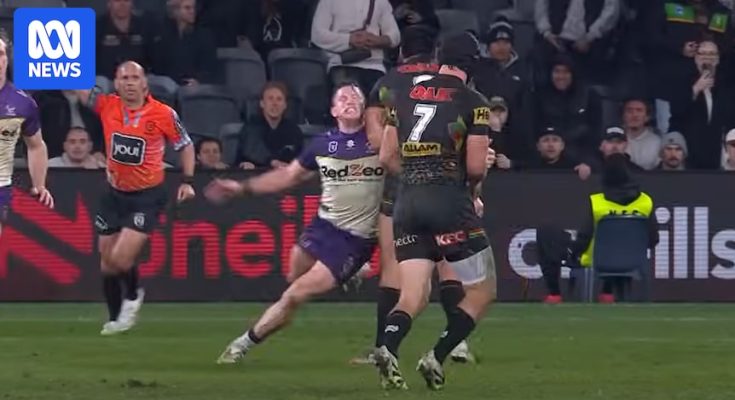In the high-stakes world of professional rugby league, every decision can have far-reaching consequences, both on and off the field. The Penrith Panthers, one of the NRL’s most successful clubs in recent years, now find themselves at the center of controversy after reportedly overlooking a crucial warning from league officials. The warning, which concerned player positioning and defensive setups during critical moments of gameplay, was issued well before the season began. Analysts, former players, and fans are now questioning why such a high-performing team failed to heed advice that could have prevented costly errors during pivotal matches.
The NRL’s warnings are not issued lightly. League officials monitor team conduct, player safety, and game integrity very closely, and they often issue directives when patterns of vulnerability are observed. In this instance, the warning reportedly involved specific formations that the Panthers had been using during training and early-season games. According to sources within the league, the formation in question had been flagged as a potential risk for opposition teams to exploit, particularly against sides known for fast ball movement and strategic kicking. Ignoring such warnings is uncommon among elite NRL teams, which makes Penrith’s decision—or lack thereof—especially perplexing.
Fans have taken to social media and discussion forums to express frustration and disbelief. Many have questioned the team’s coaching decisions, asking why such a well-established club would dismiss expert advice that could directly influence the outcome of matches. While the Panthers have enjoyed a period of dominance, recent games have shown cracks in their defensive strategy, with opposition teams repeatedly targeting specific vulnerabilities. The connection between the league’s earlier warning and these in-game issues has sparked debate among pundits, who argue that the Panthers’ oversight may have been a contributing factor to their struggles.
The decision to overlook the warning raises broader questions about risk management in professional sports. In a league where the margin for error is razor-thin, ignoring expert advice—particularly from governing bodies—can have immediate repercussions. Analysts note that teams often weigh the risks and benefits of adjusting tactics against established routines. For Penrith, sticking to their preferred formations may have seemed like a confidence-building strategy during practice sessions, but it appears to have left them exposed when facing high-pressure situations in actual matches. Such strategic rigidity can be a double-edged sword: while consistency can build team cohesion, it can also make a team predictable and vulnerable to well-prepared opponents.
The coaching staff at Penrith has remained relatively tight-lipped about the situation, issuing statements that emphasize trust in their internal decision-making processes. They argue that while the NRL’s warnings are important, the ultimate responsibility for on-field tactics rests with the team. This perspective is not without merit; professional teams often have unique insights into their players’ strengths and weaknesses, which may not be fully understood by external observers. However, the timing of recent losses and the nature of the mistakes made on the field have fueled speculation that ignoring the league’s guidance may have been a misstep. Observers suggest that a more collaborative approach between league officials and the coaching team could have mitigated the risks, ensuring the Panthers remained both competitive and compliant.
Historical context further highlights the significance of the Panthers’ situation. In previous seasons, other NRL clubs have faced penalties or public scrutiny for failing to adhere to league recommendations, whether related to player safety protocols, on-field conduct, or tactical adjustments. These incidents demonstrate that the NRL does not issue warnings lightly; there are usually precedents where ignoring advice leads to tangible consequences, from fines to reputational damage. In Penrith’s case, the issue may not have yet reached the level of formal sanction, but the reputational implications are already evident. Media coverage has been extensive, with sports commentators dissecting every tactical error and juxtaposing it against the league’s prior warning.
The fans’ perspective cannot be understated. Penrith supporters have grown accustomed to excellence, celebrating multiple championships and top-tier performances in recent years. When a warning is ignored and mistakes follow, the sense of frustration is magnified because expectations are high. Fans expect their team to not only execute plays efficiently but also to remain strategically adaptive, incorporating insights from every available source—including official league advisories. Social media has become a focal point for this dialogue, with passionate supporters debating whether the Panthers’ coaching decisions were born out of confidence, oversight, or miscalculation. Memes, opinion pieces, and heated discussions now accompany every highlight reel, reflecting the emotional investment fans have in seeing their team succeed.
From a tactical standpoint, the implications of ignoring the warning are significant. Specific formations and player positioning strategies are designed to reduce vulnerabilities and optimize performance across various scenarios. When such guidelines are dismissed, teams leave themselves exposed in ways that opposition analysts can exploit. For Penrith, the pattern has been clear in several matches where defensive misalignments allowed opposing teams to score crucial points during moments that could have been mitigated by adhering to the NRL’s advice. The league’s warning was essentially a proactive measure to prevent these exact outcomes, yet the team’s confidence in its own strategy may have inadvertently undermined its defensive integrity.
The debate also touches on the psychology of professional sports. Athletes and coaches often develop strong attachments to the strategies that have historically brought them success. Introducing external advisories—especially when the team has been performing well—can sometimes be met with resistance. The perception that league officials are overstepping or second-guessing a team’s methods may create a tension that influences decision-making. In Penrith’s case, it appears that this dynamic played a role in the team’s choice to continue with its existing formations despite the warning. While internal trust and autonomy are critical for team cohesion, balancing these elements with the guidance of governing bodies is essential for long-term success.
The implications extend beyond individual games. Ignoring league warnings can impact overall season outcomes, playoff positioning, and even player confidence. If players perceive that their coaching staff is disregarding important advice, it may lead to uncertainty on the field, hesitation in key moments, and increased likelihood of errors. For a team like the Panthers, which has championship aspirations, such risks are particularly concerning. Analysts emphasize that proactive risk management is a hallmark of elite teams, and integrating league guidance into regular strategy sessions is a fundamental aspect of maintaining competitive advantage.
Looking forward, the Panthers face several strategic decisions. Will they reassess their formations and adjust tactics in response to the warning? Will there be a cultural shift within the team to place greater emphasis on external advisories? Or will they continue to rely on internal confidence, hoping that past successes can carry them through future challenges? Each choice carries consequences that will reverberate throughout the season, influencing not only match outcomes but also the broader perception of the club within the NRL community.
The league itself may also respond if patterns of noncompliance persist. While no formal action has been reported at this stage, continued disregard for warnings could lead to increased scrutiny, mandatory briefings, or other interventions designed to protect player safety and maintain the integrity of the game. For the Panthers, the path forward is not solely about correcting tactical errors; it also involves demonstrating accountability, responsiveness, and a willingness to engage constructively with league guidance. Doing so would not only protect the team’s on-field performance but also reinforce the Panthers’ reputation as a professionally managed and strategically savvy organization.
In conclusion, the situation surrounding the Penrith Panthers’ decision to overlook a critical NRL warning highlights the delicate balance between internal confidence and external guidance in professional sports. While the team has historically demonstrated remarkable skill and cohesion, recent missteps underscore the importance of remaining adaptable, receptive to advice, and proactive in addressing vulnerabilities. Fans, analysts, and league officials alike are watching closely, eager to see whether the Panthers will adjust their approach or continue to rely on established routines. The phrase “Why put them there?” has now taken on a larger significance, symbolizing not just tactical errors but also the broader challenge of navigating complex decisions in high-stakes competitive environments. For Penrith, the lesson is clear: ignoring warnings may feel comfortable in the short term, but in the unforgiving arena of professional rugby league, it carries consequences that are impossible to overlook.



